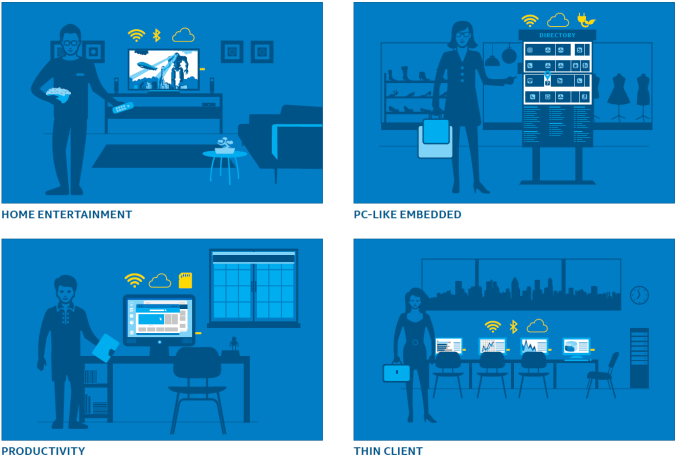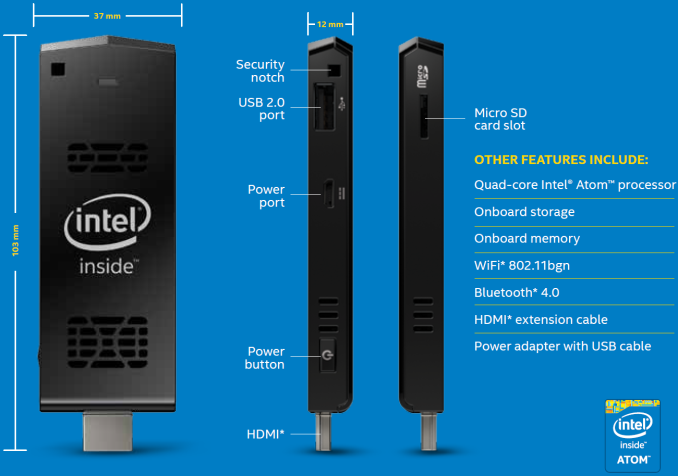Intel PPSTCK1A32WFC Bay Trail-T Compute Stick Review
by Ganesh T S on April 22, 2015 11:00 AM EST- Posted in
- Systems
- Intel
- Bay Trail
- HDMI Stick
Concluding Remarks
The Intel Compute Stick gave us the opportunity to see whether a tablet SoC could provide enough horsepower for a desktop PC. Based on our experience, the answer to that question is cautiously in the affirmative. There is no doubt that the device can do well as an economical solution for thin clients, kiosks and digital signage. These are scenarios where only one program runs for the life of the system and the OS is rarely updated.
The Compute Stick could do with some improvements for the scenarios in the left column
Traditional PCs have a different use-case compared to PC-like embedded systems and that brings us to the first problem in the Compute Stick we reviewed:
- OS drive size
32 GB, simply put, is just not enough after Windows installs a couple of updates. Out of the box, the system had around 17 GB free in the 23 GB disk (the rest, presumably, is the OS recovery partition). An initial update check resulted in a 1.3 GB download, and that installation brought down the free space to 14.3 GB. We have always been wary of Windows Updates on machines with low free space on the primary drive. As feared, attempting to install another round of updates resulted in a botched update problem (solved here). We had to spend 4+ hours getting the unit back to the initial state with a 'refresh' operation (and reinstall all the updates once again). To top it off, Windows lost activation in the refresh process and refused to reactivate (indicating a blacklisted key).
- Thermal design / solution
There is no doubt that the thermal design is very effective. Acoustic measurements come in at 28 dB at 1m distance. However, the irregular nature of the small-diameter fan makes for a strained experience if the user sits very close to the Compute Stick (possible in an office environment). It would not be a bad idea to go for a passively cooled Compute Stick at the cost of a slight increase in cost, weight and/or size.
- WLAN solution
The unit doesn't come with any wired networking facilities. It is essential that the Wi-Fi solution be top-notch. Unfortunately, a single-band 1x1 802.11n solution just doesn't cut it - particularly for scenarios involving video streaming. Thankfully, the presence of Bluetooth makes a USB keyboard / mouse unnecessary, freeing up the single USB 2.0 port for other purposes. Talking of video streaming, it would also be nice to have full HD audio support in the GPU drivers for Bay Trail-T (now that it has made its appearance in a mini-PC).
Despite the above shortcomings, the Compute Stick did impress us in a few areas - the form factor and portability aspects are praiseworthy. The CPU performance is not as bad as we feared it would be - Windows loads in a smooth manner and the system is as responsive as what one can expect from a Bay Trail-based mini-PC.
Coming to the business end of the review, we can say that the Intel Compute Stick is a typical first-generation product. In our opinion, there are way too many compromises being made to get to this form factor. There are certainly applications where the kit would be perfect, but general-purpose day-to-day computing is not one of them. If Intel wants the Compute Stick product line to take off like NUCs, addressing the three main shortcomings detailed above would be a good first step.












103 Comments
View All Comments
Drumsticks - Wednesday, April 22, 2015 - link
Thanks for the review. Can somebody smarter than me explain why exactly 23.976 Hz is important? I assume that's the refresh rate used in movies, but is deviating slightly from that really so noticeable, or why is it so important? *never messed with HTPC stuff*Guspaz - Wednesday, April 22, 2015 - link
In the worst case, you're going to display those 23.976 FPS movies on a 60Hz screen. But they don't divide evenly. Ideally, you want each image to be on the screen for ~41.7ms, but a 60Hz display only works in multiples of ~16.7ms. So the closest you can get is displaying each image for ~33.3ms.But as you can see, 33.3ms is not the same as 41.7ms, so you end up having to display some frames for 33.3ms, and some frames for 50ms. The result is that motion that should be smooth appears jittery, because each frame is displayed for a different amount of time.
The closer your display can get to actually displaying 23.976Hz, the fewer frames you'll need delay like that. If your display can do an even 24Hz, then you'll need to double up a frame every ~42 seconds. Not so bad. And the closer you get, the longer between doubled frames. And if you nail it at 23.976Hz, then you never double frames, and it looks great.
madwolfa - Wednesday, April 22, 2015 - link
FWIW, I'm just using Smooth Motion feature of MadVR and it works great with 60Hz displays and 24 FPS content. Needs some GPU power, though.joex4444 - Wednesday, April 22, 2015 - link
The 23.976Hz is technically 24/1001, almost as if it originally derived from an "off-by-one" error in computing frames. Anyways, any multiple of that works just as well as the 23.976Hz display rate. Similarly, any multiple of 24Hz works as well as 24Hz.And one may ask what rates are available that are multiples of 24Hz to find a good solution. For example, 48Hz and 96Hz don't exist nor does 72Hz. The next multiple would be 120Hz, so by displaying each frame 5 times, each time lasting 8.34ms, one can similarly achieve a scenario that is fairly jitter free. Though in this case one wouldn't have to occasionally display a frame for an extra 16.67ms, but instead an extra 8.34ms.
The next multiple available would be 6, yielding 144Hz and a refresh time of 6.95ms.
In these cases that means going from 60Hz to 144Hz implies that when a frame is displayed an extra refresh cycle to kick the clock back in sync (like leap day does with the calendar), the "lag" experienced decreases from 16.67ms to 6.95ms, making that effect less than half as noticeable. However the real change from 60 to 120/144Hz is that the latter is a multiple of 24 while the former is not. The former, as you say, requires one to either display things for 33.3ms or 50ms and that causes some noticeable problems depending on the scene. Human reaction time is about 100ms, perhaps 80ms in someone young. However that's the time to react to something, we notice things on a shorter scale (see fighter pilots).
Laststop311 - Thursday, April 23, 2015 - link
Actually plasma displays do have 72hz and 96hz refresh rates. Pioneer kuro's have a 72hz refresh mode and panasonics have 96hz refresh mode. The cheaper panasonics have a 48hz mode but it introduced flicker that made it unwatchable so 72hz was the slowest refresh rate that is watchable and compatible with 24 fps film. This was one of their big selling points as they can natively play 24fps blu ray films at their intended speed without 3:2 pulldown. I know this for a fact as I have a Panasonic plasma that can accept a 1080p24 signal from a bluray using 96hz by repeating each frame of the movie 4 times 4:4 pulldown i believe.kyuu - Wednesday, April 22, 2015 - link
I'm not 100%, but I believe the issue is that the disparity in the refresh rate adds up over time and results in skipped frames here and there.babgvant - Thursday, April 23, 2015 - link
Refresh rate accuracy is important because when it's wrong frames get dropped to keep A/V in sync. For 24p (23.976) this is especially important because there are fewer frames, so it's much more noticeable. In this case 23.973 isn't bad (i.e. there won't be many frames that go missing), but it's not what we've come to expect, and enjoy, from Intel's other systems that get it pretty much perfect.nathanddrews - Wednesday, April 22, 2015 - link
Fortunately, you can pick up 100Mb and 1GbE USB adapters for under $10, so the networking performance can be greatly improved with little effort... but the lack of HD bitstreaming is a complete fail for HTPC use. If it's anything like my other Bay Trail devices, it will also struggle with Steam In-Home Streaming.Can't wait for v2.0!
mwildtech - Wednesday, April 22, 2015 - link
I have a Baytrail powered Zotac Pico PI320. I'm using the 10/100 Ethernet port, and it does Steam in-home streaming @ 1080p/60 pretty well. Though Baytrail doesn't have QuickSync, the DVXA decoder does a decent job.ganeshts - Wednesday, April 22, 2015 - link
The issue I foresee is that if you are going to make the setup unwieldy with an adapter hanging off the Compute Stick - then, the advantage of the form factor is lost. You might as well pick up one of the other mini-PCs compared in this review, but that is just my opinion